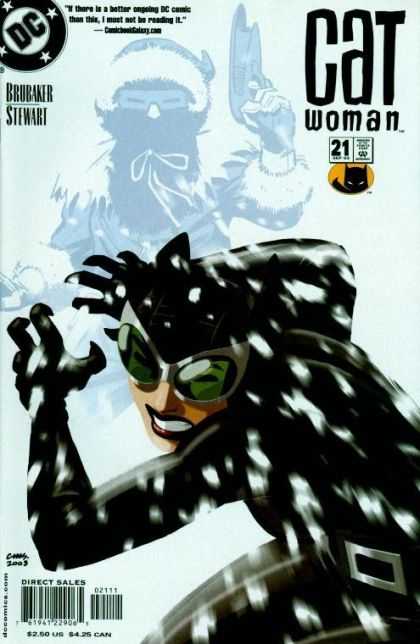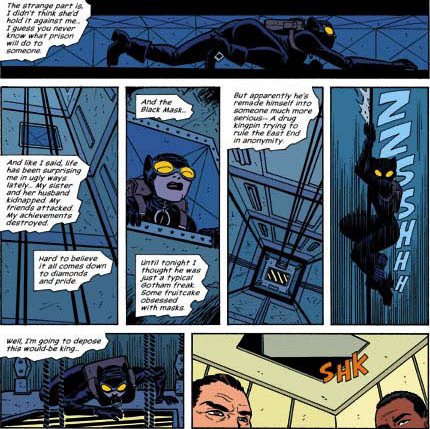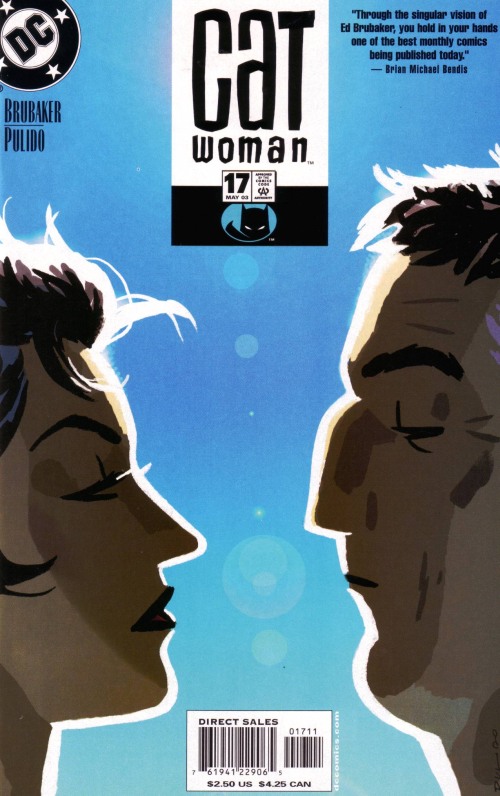Brubaker’s Catwoman: an appreciation
by Martin Skidmore 20-Feb-11
A belated apology for not following Brubaker from many years ago, thanks to finally reading his superb Catwoman run.
My regular readers, if such exist, may have grasped that for some years I’d not been buying a lot of comics. I lost track when unemployed and then as a ‘mature’ (i.e. old) student – not much money to spend, and comics are crap value when you have to time to fill and can wander into a charity shop and buy a good novel for half the price of a new American comic. I just about kept up with a few old favourites, to which Bendis got added after friends’ recommendations some years back. Somehow I never got around to adding Ed Brubaker, and I wish I had. (Apologies to my friend Jenni, who had told me how good he was.)
My lovely regular comic shop, Gosh!, was celebrating its 25th anniversary recently, and was offering anything from its back issue bins at 25p each. Nearly half of my substantial haul was 31 Catwoman issues – I’d read a couple of collections thanks to the library, so knew I’d like them. As it turns out, I love them.
She’d never been a particular favourite character of mine. I don’t really recall any special Batman stories centring on her, and I’d not read any of the reboots before this, so I don’t know much this is in keeping with them. Here she is in Gotham City and is more or less a hero, but not so far from still being a thief. She still has an edgy relationship with Batman, with plenty of passion but some ambiguity, where he has faith in her but nonetheless some suspicion too.
I really like her supporting cast here. She shares a flat with a young woman named Holly, her best friend, who is a particularly lively and complex character. Holly’s girlfriend Karon is a little underused, underdeveloped even, but I like their relationship – partly because no one ever makes a fuss about it being between two women, but also there is an affection and trust, and none of the usual soapy nonsense or melodrama. We also get a lot of Slam Bradley, a veteran (as a DC character as well as being an old guy here: he predates Superman and Batman) hardboiled PI, who has an important role in many of the plots, but also a developing relationship with Selina that goes way beyond the professional. There are others too, friends and friends of friends and family, together giving a sense of someone in a believable and complex web of personal relationships that is surprisingly uncommon in superhero titles.
These relationships are handled with intelligence and care throughout. The friendship then affair with Slam is full of ups and downs, stresses and upsets, all arising from their characters and situation. There’s a particularly sharp confrontation between Slam and Batman in one issue, both wanting Selina, both knowing that neither will ever really have her the way they might want.
One of the challenges facing any writer of a comic in the two giant shared universes is the dilemma between making their title a part of the whole and making it a distinct world of its own. I’m extraordinarily impressed with how well Brubaker judges and juggles this. Catwoman is embedded in the DC universe not just by her relationship with Batman but by her history, with villains like the Penguin, a major player in Gotham during this era, and with other heroes. We get a lot of Ted (Wildcat) Grant in this, but also guest shots from Hawkman and Hawkwoman – there is no mistaking that Selina is part of this bigger world with its super-science and aliens and magic.
But she has her own world too: most of the art here, which I’ll return to shortly, gives her environment an old-fashioned feel, that of film noir perhaps, always a good fit with the established atmosphere of Gotham City. Beyond that, Selina claims a territory, the East End, from her own personal history, in which she lives, and which she decides to protect. She has no problem with crime of most sorts going on there, but she aims to see that innocents are protected. She interprets this in a way that wouldn’t work for any other character I can think of – she has no problem for instance with drug dealing, except when kids are involved or bystanders are attacked. As the story goes on, she accrues, almost by inheritance, a gang of street kids, educating them at least partway from their previous existence (something like Fagin’s gang) into something more like Sherlock Holmes’ assistants. Selina is embedded in this world, this part of the city, both by personal history and current ties and by her self-appointed role as its guardian, always under strain from mob incursions of various kinds.
This role means the stories tend to start with street-level crime, leading inevitably to confrontations with the big guns of Gotham’s underworld, some of them established characters, some new ones. These plots are worked out with some care, by a writer who seems to understand the problems in real crime, the way it works, the grey areas. We get Rogues’ Gallery-type crime lords, corrupt cops, hired thugs and assassins, drug dealers at small and large levels, all with their own personalities and ways of working and motivations. We get people with all kinds of links to Catwoman’s past – this is arguably overdone in parts, I thought, but not so much as to really bug me.
There is one serious departure from this style of story, something of a misstep I thought, when she accidentally gets involved with some ancient Egyptian cult. This leads to several issues where she is attacked by Arabs with swords, to no very obvious purpose, and then this strand is ended quickly and unconvincingly (it doesn’t at all account for why they were attacking her), as if Brubaker had grown tired of it and realised it wasn’t a winner.
But most of it is terrific, especially when the story slows down. I particularly liked the mosaic of short scenes when Javier Pulido was drawing: brief focuses on the various characters and how they are feeling and interacting, an absolute delight. There’s also an excellent road trip story, the touching purpose of which only comes out at the end, but the relationship with her companion Holly is at its best here.
Of course no comic works just because of good writing. I have plenty of favourites where the art just barely serves the story (say Gerber’s Defenders, where Sal Buscema narrates unspectacularly but fairly efficiently), or where it’s a positive hindrance to my love of the writing (much of Grant Morrison’s work, including his JLA for instance), but here Brubaker is mostly wonderfully well served. For most of the run, the style is cartoony – I was reminded at various times of Batman: The Animated Series, of Darwyn Cooke (who drew the early issues I’d already read in trade form), of both Hernandez Brothers, all styles I really like. Cameron Stewart, Brad Rader and Javier Pulido all give her world real charm, and bring the characters very vividly to life. There are a couple of issues pencilled by Guy Davis, a recent new favourite of mine, but the Stewart inks make these less distinct than I would have expected. A key point here is that you really don’t need gritty, agonised, realistic art to tell gritty, serious stories, and the mainstream companies rarely seem to grasp this.
I was less pleased when Paul Gulacy took over on later issues. His work is not at all in this style, more realistic, almost photo-real in places, more like the traditional Marvel and DC styles. While he produces plenty of attractive moments, he also, as ever, screws up in places, giving us some clumsily distorted faces and figures. Too much tendency towards cheesecake poses for Catwoman, too. I was also puzzled by his decision to transform Slam Bradley from the broad, muscular tough guy into a lookalike for the rangier Robert Mitchum – Gulacy has always been keen to model characters on famous faces, but doing this with an established character, you need to choose someone of at least the same physical type (though I guess the face is a tolerable fit).
So Brubaker’s final issues didn’t delight me as much as those before, but overall this is one of the best lengthy runs on a title I’ve read in many years, full of intelligence, charm, craft, likeable and interesting characters, lively and inventive stories, subtle and strong dialogue and largely wonderful art. A superb series, and one that has made me a total convert to Brubaker.
Tags: Batman, Brad Rader, Cameron Stewart, Catwoman, DC, Ed Brubaker, Javier Pulido, Paul Gulacy


“You really don’t need gritty, agonized, realistic art to tell gritty, serious stories.”
Too true!
“I was reminded at various times of Batman: The Animated Series, of Darwyn Cooke […], of both Hernandez Brothers…”
Jaw-dropping statement, and entirely true, too! DC should put this on the backs of the Catwoman trades. It’s basically like a strip-mall church using their awkward letter board to advertise themselves as “Similar to Yahweh, Jesus and Allah.”
A terrific run, possible one of the best of the last ten (++) years, nicely consistent tone that builds its own world within a world with effortless expertise. Its no surprise that when Bru went off to Marvel that they tried a fit with a few of their more self contained characters, or at least they allowed him to make Captain America more self contained.
But this run actually makes the most sense of any vigilante that either of the big two ever have. A self interested altruist, Catwoman looks out for her people, with the knowledge that she can’t save the world comes the realisation that she can save her friends. A perfect fit to her larceny, since vigilantism is illegal, why would boy scout superheroes do it? If your day job is a criminal, it makes a lot more sense that you would be more comfy with breaking the rules to look after your own.
Wonderful stuff.